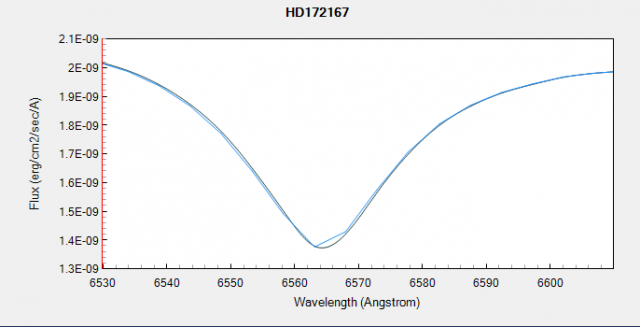Forum Replies Created
-
AuthorPosts
-
 Dr Andrew SmithParticipant
Dr Andrew SmithParticipantCan you not just image link and sync on that?
Regards Andrew
 Dr Andrew SmithParticipant
Dr Andrew SmithParticipantI would more than happy to help. I also now have experience of doing very low resolution spectroscopy at a remote hosted site. I am develop a new instrument based on an alpy which will use similar techniques to the high resolution work.
Regards Andrew
 Dr Andrew SmithParticipant
Dr Andrew SmithParticipantWell done David an interesting read. Regards Andrew
 Dr Andrew SmithParticipant
Dr Andrew SmithParticipantFunny I missed those.
 Dr Andrew SmithParticipant
Dr Andrew SmithParticipantAchromatic, tracking, field rotation. Eyepieces bring a new set kidney bean, astigmatism, distortion….
Regards Andrew
 Dr Andrew SmithParticipant
Dr Andrew SmithParticipanthttps://www.atik-cameras.com/core-software-downloads/
Regards Andrew
 Dr Andrew SmithParticipant
Dr Andrew SmithParticipantSorted thanks
 Dr Andrew SmithParticipant
Dr Andrew SmithParticipantThis looks like an instrument / programming task in the context of astronomy. If your interested go for it.
Regards Andrew
 Dr Andrew SmithParticipant
Dr Andrew SmithParticipantVery, very, tempting and would love to do it. However, at 69 I should perhaps leave it to a younger candidate in need of the experience.
Regards Andrew
 Dr Andrew SmithParticipant
Dr Andrew SmithParticipantYes but given the low read noise you can stack multiple short exposures to get the same S/N ratio. This is the normal strategy with CMOS cameras.
Regards Andrew
 Dr Andrew SmithParticipant
Dr Andrew SmithParticipantYou might find what you want here https://www.edmundoptics.co.uk/f/first-surface-mirrors/12017/
Regards Andrew
 Dr Andrew SmithParticipant
Dr Andrew SmithParticipantYou should convert ADU to e using the (inverse) gain in e/ADU for a real measure of S/N. This is probably what your software is not taking into account. The gain does not change the number of photons captured (assuming it’s not saturated ) .
You can quite easily measure the gain in the right units see here for example http://www.astrosurf.com/buil/isis/noise/result.htm
Regards Andrew
 Dr Andrew SmithParticipant
Dr Andrew SmithParticipantI am not sure I agree with this. Yes increasing the gain reduces the well depth but thus can be compensated for by take more shorter exposures and or defocusing.
Increasing the gain reduces both the read noise and the quantisation noise.
There is a balance to be had trading off these factors. I use a gain of 200 (ASI gain) for my spectroscopy.
Regards Andrew
 Dr Andrew SmithParticipant
Dr Andrew SmithParticipantHave a look at this http://www.astrosurf.com/buil/atik_vs_zwo/
Regards Andrew
 Dr Andrew SmithParticipant
Dr Andrew SmithParticipantI have converted the STScI Calspec spectra from there original fit table format to a “flat” fits format that can be read by BassProject and ISIS. One or two obscure spectra did not convert. I have included some notes (with spelling mistakes) and a Excel catalogue culled from the two on the Calspec site.
I have sent a copy of the 20.5 Mb zip file to Andy to consider making it available from the BAA web site.
I eyeballed all the spectra and checked a small random sample against the originals using Tim Lester’s PlotSpectra which can display the original along side the converted ones.
Here is a comparison of the original and converted spectra of Alpha Lyr. Black is converted blue original.

I anyone needs it now I am happy to email it to you.
Regards Andrew
 Dr Andrew SmithParticipant
Dr Andrew SmithParticipantWhat I will do is do two zip files one with everything (may not do the NGC entries) and one with just A & B stars. It will take a few days to do the all!
Regards Andrew
PS Just did them all in the end as it was simpler.
 Dr Andrew SmithParticipant
Dr Andrew SmithParticipantI only new 1 possibly 2 answers. I have not entered Regards Andrew
 Dr Andrew SmithParticipant
Dr Andrew SmithParticipantHi Andy – I think less than 60 files (20 or so if restricted to A or B stars). I am putting them in text files in the ISIS .dat format ( wavelength flux) so far the are all under 9,800 KB the names are as in the CALSPEC catalogue https://www.stsci.edu/hst/instrumentation/reference-data-for-calibration-and-tools/astronomical-catalogs/calspec .
I could put them in fits format but I am not sure (need to test) if that would require me to resample them to a fixed wavelength interval and I would rather not change the data.
Regards Andrew
 Dr Andrew SmithParticipant
Dr Andrew SmithParticipantTwo things one the equation if time so that meridian crossing of the sun is not exactly at noon or midnight UTC and sea tides lag the moon position. Not sure what impact they have though.
Regards Andrew
 Dr Andrew SmithParticipant
Dr Andrew SmithParticipantNot sure about that as both V and I can vary and one is not pinned. In this case it may not be a problem as the depths of the bands clearly varies. However, it does concern me in general when continuum changes are significant as with my flare spectra.
Regards Andrew
-
AuthorPosts
